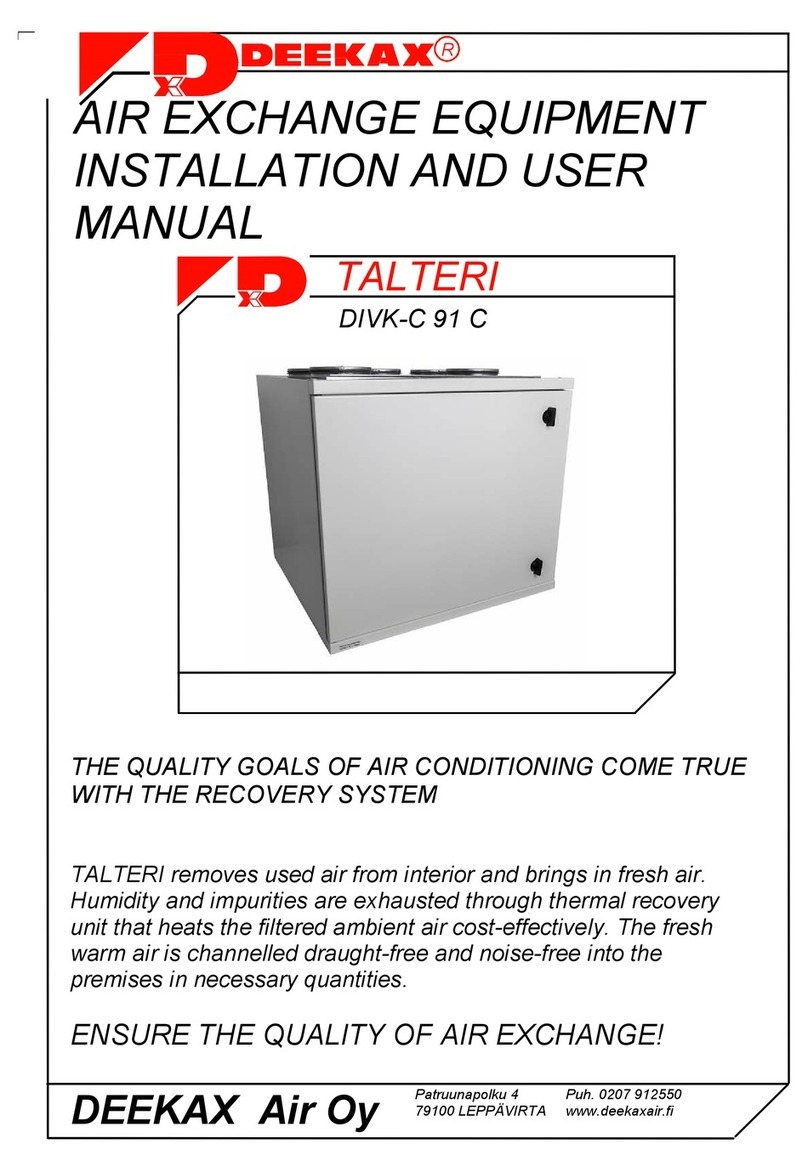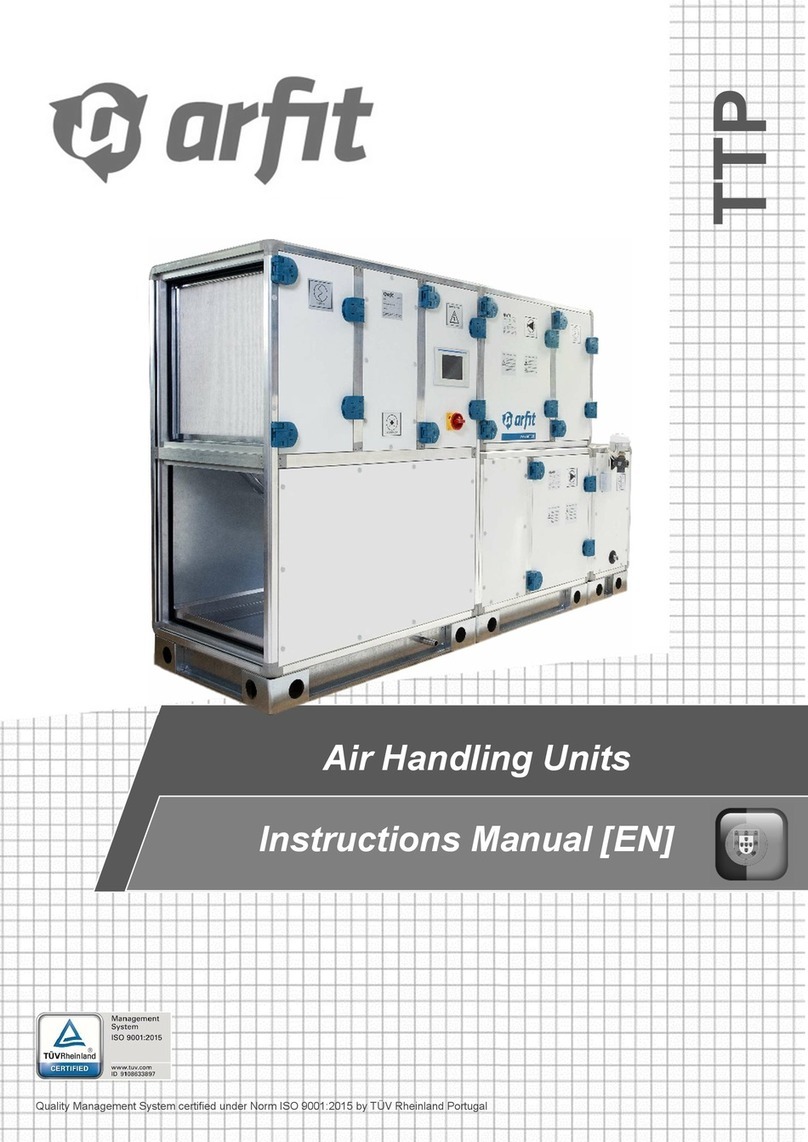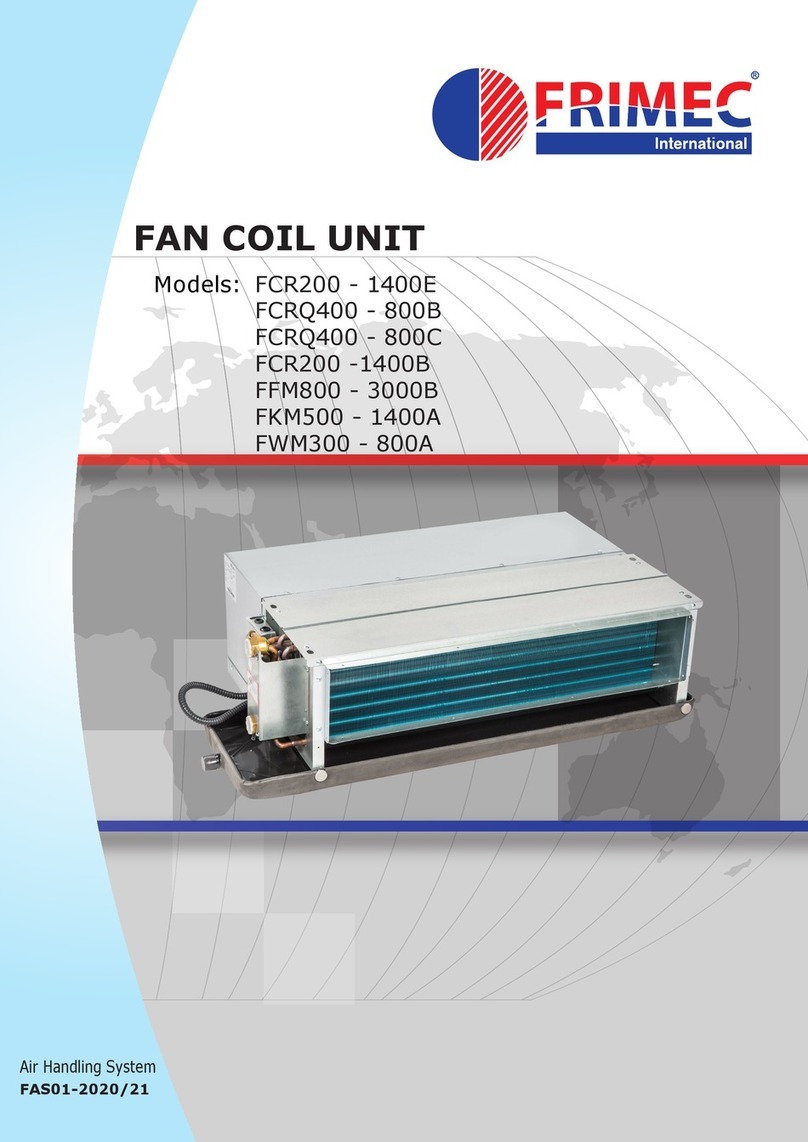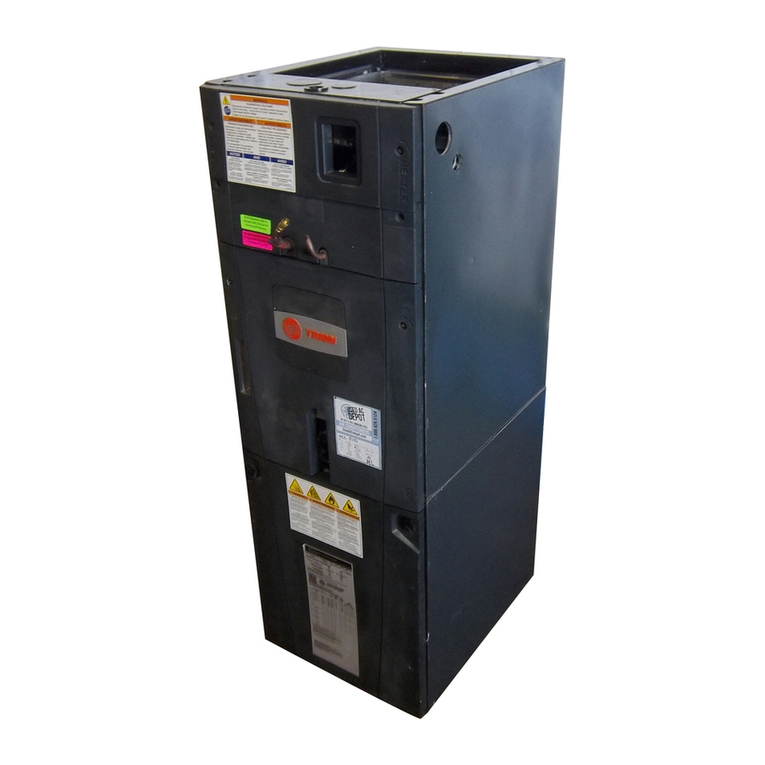Aero EVO-R User manual

EVO-R
COMPACT AIR HANDLING UNIT WITH ROTARY HEAT RECOVERY

2
Table of Contents
CHAPTER 1 GENERAL INSTALLATION AND OPERATING INSTRIUCTIONS
1.0
Important information……………………………………………….....................................................................................
Page 6
1.1
Warning and safety instructions …….…………………………….....................................................................................
Page 6
1.2
Warranty claims –Exclusion of liability………………………….......................................................................................
Page 6
1.3
Regulations –Guidelines…………………………............................................................................................................
Page 7
1.4
Receipt…………………………........................................................................................................................................
Page 7
1.5
Storage………………………….......................................................................................................................................
Page 8
1.6
Transport…………………………....................................................................................................................................
Page 8
1.7
Intended use…………………………...............................................................................................................................
Page 10
1.8
Heat systems…………………………..............................................................................................................................
Page 11
1.9
Performance and technical data………………………….................................................................................................
Page 11
1.10
Disassembly and re-assembly…………………………....................................................................................................
Page 12
1.11
Disposal…………………………......................................................................................................................................
Page 12
CHAPTER 2 INSTALLATION
2.0
Assembly…………………………………………………………………………………………………………………………..
Page 13
2.1
General installation information………………………………………………………………………………………………
Page 14
2.1.1 Levelling of unit……………………………………………………………………………………………………………..
Page 14
2.1.2 Attachment of door handles……………………………………………………………………………………………….
Page 14
2.1.3 Module assembly…………………………………………………………………………………………………………...
Page 15
2.1.4 Flange connection / adapter pieces………………………………………………………………………………………
Page 16
2.1.5 Air ducting…………………………………………………………………………………………………………………...
Page 17
2.2
Additional instruction for outdoor use……………..………………………………………………………………………..
Page 17
2.3
Electrical connection……………………………………………………………………………………………………………
Page 18
2.3.1 Power supply connection…………………………………………………………………………………………………..
Page 18
2.3.2 HMI connection for E3-DSP and ED-T7 display………………………………………………………………………...
Page 19
2.3.3 Attachment of main switch…………………………………………………………………………………………………
Page 20
2.4
Commissioning assistant………………………………………………………………………………………………………
Page 20
CHAPTER 3 FUNCTIONAL DESCRIPTION
3.0
Unit overview……………………………………………………………………………………………………………………….
Page 21
3.1
Functions……………………………………………………………………………………………………………………….......
Page 25
3.1.1 Electrical pre heater………………………………………………………………………………………………………...
Page 25
3.1.2 CAP mode…………………………………………………………………………………………………………………...
Page 25
3.1.3 CRPM mode…………………………………………………………………………………………………………………
Page 25
3.1.4 VOD mode…………………………………………………………………………………..………………………………
Page 25
3.1.5 Modbus / Bacnet……………………………………………………………………………………………………………
Page 25
CHAPTER 4 CONTROLLER
4.1
Commissioning…………………………………………………………………………………………………………………...
Page 26
4.1.1 Language selection ………………………………………………………………………………………………………...
Page 27
4.1.2 Device selection………………………………………………………………………….……………………………........
Page 28
4.1.3 External 0-10v control of the fans ……………………………………………...……………………………..................
Page 28
4.1.4 Temperature Control Mode ………………………………………………...……………………………...…….............
Page 28
a. Constant Supply Air Temperature Control ………………………………………………………………………………..
Page 29
b. Outdoor Compensated Supply Air Temperature Control……………………………...…………………...…...…….…
Page 30
c. Cascade Room Temperature Control………………………...……………………………...……...……...……………..
Page 31
d. Cascade Extract Air Temperature Control……………………………...……………………………...……...……........
Page 31
e. Outdoor Dependent Supply or Room Temperature Control……………………………...……………………………..
Page 32
f. Outdoor Dependent Supply or Extract Air Temperature Control……………………………...……...……...……........
Page 33
g. Outdoor Compensated Room Temperature Control……………………………...……………………………...……...
Page 33
h. Outdoor Compensated Extract Air Temperature Control……………………………...………………………...……...
Page 35
4.1.5 Ventilation Mode…...…………………...………………………………………………...………………………………...
Page 36

3
a. Constant Air Flow…….………………………………………………………………………………………………………
Page 36
b. Constant RPM………………………………………………………………………………………………………………..
Page 37
c. Constant Pressure…………………………………………………………………………………………………………...
Page 37
d. External Fan Control…………………………………………………………………………………………………………
Page 38
4.1.6 Electrical Preheating………………...…………………………………………………...………………………………...
Page 38
4.1.7 Supply Air Filter Type……………....………………………………………………...…………………………………....
Page 38
4.1.8 Extract Air Filter Type…………………...………………………………………………...………………………………..
Page 39
4.1.9 After Heater Type…………………...………………………………………………...…………………………………....
Page 39
4.1.10 Cooler …………………...…..…………………………………………...………………………………………………..
Page 39
4.1.11 Recirculation Damper …………………...………………………………………………...……………………………..
Page 39
4.1.12 By pass / Free cooling (night cooling)………………………………………………………………………………….
Page 40
4.1.13 Ventilation on demand (VOD)…………...……………………………………………...……………………………….
Page 41
4.1.14 Leaving the commissioning assistant.………………………………………………...………………………………...
Page 43
4.2
Running Modes…………………………………………………….…………………………………………………………….
Page 43
4.2.1 Manual operation…………………………………………………………………………………………………………...
Page 44
4.2.2 Timers………………………………………………………………………….……………………………......................
Page 44
a. Time/Date Set………………………………………………………………………………………………………………...
Page 44
b. Day/Week Program……………………………...…………………...……………………………………………………..
Page 45
c. Holiday………………...……………………………...……………………….……………………………………………...
Page 46
d. Extended Running……………………………...……………………………...…………………………………………….
Page 46
4.2.3 Ventilation on demand (VOD)……………………………………………….……………………………......................
Page 47
4.3
Functions…………………………………………………………………………………………………………………………..
Page 49
4.3.1 Recirculation Damper...…………………………………………………………………………………………………….
Page 49
4.3.2 Bypass / Free Cooling (Night Cooling)………………………………………….…………………………….................
Page 50
4.3.3 Emergency Operation/Fire mode……………………………………………...……………………………...................
Page 51
4.3.4 Exchanger Deicing………………………………………………...……………………………......................................
Page 51
4.3.5 Frost Protection WW Heating Coil……………………….………………………………………………………………..
Page 52
4.3.6 Filter monitoring……………………….……………………….……………………………………………………………
Page 52
4.4
Priorities …………………………………………….…………………………………………………………………………….
Page 52
4.5
User Level/access rights ……………………………………………………………………………………………………….
Page 53
4.6
Alarm ……………………………………………………………………………………………………....................................
Page 54
CHAPTER 5 DIMENSIONS –PERFORMANCE CURVE
5.0
Dimensions.………………………………………………………………………………………………………………………..
Page 56
5.1
Performance curve……………………………………………………………………………………………………………......
Page 59
CHAPTER 6 SERVICE AND MAINTENANCE
6.0
Service and maintenance….……………………………...................................................................................................
Page 63
6.1
Service and maintenance of rotary heat exchanger…………………..…….....................................................................
Page 63
6.2
Filter change………………………...……………………………........................................................................................
Page 66
6.3
Service and maintenance of fan.…………………………………………..........................................................................
Page 67
6.4
Cleaning of housing…………………………………………………………………………………………………………….
Page 69

4
CHAPTER 7 ACCESSORIES
7.0
Accessory list………………………….…………………...………………………………………………...………………….
Page 70
7.1
Water after heater
7.1.1 Functional description of water after heater……………..…………………………………………….………………...
Page 79
7.1.2 Installation of water after heater……………..…………………………………………….………..……………………
Page 79
7.1.3 Service and maintenance of water after heater..…………………………………….………………………………….
Page 83
7.2
Electrical after heater
7.2.1 Functional description of electrical after heater……………..……………………………………………..……………
Page 84
7.2.2 Installation of electrical after heater……………..…………………….………………………….………………………
Page 85
7.2.3 Service and maintenance of electrical after heater……………..…………………..………….………………………
Page 89
7.3
Electrical pre heater
7.3.1 Functional description of electrical pre heater……………..…………………..…………………………..……………
Page 91
7.3.2 Installation of electrical pre heater……………..…………………….…………..……………….………………………
Page 92
7.3.3 Service and maintenance of electrical pre heater……………..………………..…..………….………………………
Page 95
7.4
Outdoor air pre filter
7.4.1 Functional description of outdoor air pre filter……...……..…………………..………….………………………..……
Page 96
7.4.2 Installation of outdoor air pre filter……………..…………………..………….………………………………………….
Page 96
7.4.3 Service and maintenance of outdoor air pre filter……...……..…………………..………….…………………………
Page 97
7.5
Recirculation damper
7.5.1 Functional description of recirculation damper……..…………………..………….……………………………….…..
Page 97
7.5.2 Installation of recirculation damper……..…………………..……….……………………………………………………
Page 97
7.5.3 Service and maintenance of recirculation damper……..…………………..………….……………………………….
Page 19
7.6
Outdoor damper
7.6.1 Functional description of outdoor damper……..…………………..………….…………………………………………
Page 99
7.6.2 Installation of outdoor damper……..…………………..………….………………………………………………………
Page 100
7.6.3 Service and maintenance of outdoor damper……..…………………..………….…………………………………….
Page 101
7.7
Cooling coil DX
7.7.1 Functional description of cooling coil DX……..…………………..………….………………………………………….
Page 102
7.7.2 Installation of cooling coil DX……..…………………..………….……………………………………………………….
Page 102
7.7.3 Service and maintenance of cooling coil DX……..…………………..………….……………………………………...
Page 105
7.8
Cooling coil water
7.8.1 Functional description of cooling coil water……..…………………..………….………………………………………
Page 107
7.8.2 Installation of cooling coil water……..…………………..………….…………………………………………………….
Page 108
7.8.3 Service and maintenance of cooling coil water……..…………………..………….…………………………………...
Page 110
7.9
Weather roof
7.9.1 Functional description of weather roof……..…………………..………….……………………………………………..
Page 112
7.9.2 Installation of weather roof……..…………………..………….………………………………………………………….
Page 113
7.9.3 Service and maintenance of weather roof……..…………………..………….…………………………………………
Page 118
7.10
Module weather roof
7.10.1 Functional description of module weather roof …………………………..……..………….…………………………
Page 118
7.10.2 Installation of module weather roof …………..………….……………………………………………..………………
Page 119
7.10.3 Service and maintenance of module weather roof…………………………………..………….…………………….
Page 120
7.11
Outdoor –exhaust air spigot
7.11.1 Functional description of outdoor –exhaust air spigot…....…………………..………….…………………………..
Page 120
7.11.2 Installation of outdoor –exhaust air spigot……..………..………….………………………..………………………..
Page 121
7.11.3 Service and maintenance of outdoor –exhaust air spigot……..…………………………….………………………
Page 121
7.12
E-box heater
7.12.1 Functional description of e-box heater……..…………………..………….…………………………………………...
Page 122
7.12.2 Installation of e-box heater……..…………………..………….………………………………………………………...
Page 122
7.13
Adapter rectangular-round
7.13.1 Functional description of adapter rectangular-round...…………………..……………………………………………
Page 123
7.13.2 Installation of adapter rectangular-round ………………………………………………………..…………………….
Page 123
7.13.3 Service and maintenance of adapter rectangular-round ……………………………………………………………..
Page 124
7.14
Flexible duct connection
7.14.1 Functional description of flexible connection...…………………………...……………………………………………
Page 124
7.14.2 Installation of flexible connection …………………………………………………..……………..…………………….
Page 124
7.14.3 Service and maintenance of flexible connection ………………………………………….…………………………..
Page 124

5
7.15
CAP-modus
7.15.1 Functional description of CAP-modus………....………………………...………………………………………..……
Page 124
7.15.2 Installation of CAP-modus………..………………………………………………..……………..……………….….….
Page 124
7.16
CO duct sensors
7.16.1 Functional description of CO2 duct sensor………..………....……………………………..…………………………
Page 125
7.16.2 Installation of CO2 duct sensor…..………..……………………………...………………..……..…………………….
Page 125
7.17
CO2 room sensors
7.17.1 Functional description of CO2 room sensor………..………....…………………………….…………………………
Page 125
7.17.2 Installation of CO2 room sensor…..………..…………………………….....……………..……..…………………….
Page 125
7.18
VOC-sensor
7.18.1 Functional description of VOC-sensor……....…………………………...……………………………………………
Page 125
7.18.2 Installation of VOC-sensor……..……………...…………………………………..……………..…………………….
Page 125
7.19
FTF sensor
7.19.1 Functional description of FTF sensor………..………....…………………………...…………………………………
Page 125
7.19.2 Installation of FTF sensor…..………..……………………………………………………..……..…………………….
Page 125
7.20
Signal converter
7.20.1 Functional description of signal converter………………………………...……………………………………………
Page 126
7.20.2 Installation of signal converter………………………………….…………………..……………..…………………….
Page 126
7.21
Siphon for cooling module
7.21.1 Functional description of siphon for cooling module…………………………………………………………………..
Page 126
7.21.2 Installation of siphon for cooling module……………………………………………….………..……………………..
Page 126
7.21.3 Service and maintenance of siphon for cooling module………………………………………………………………
Page 127
CHAPTER 8 WIRING DIAGRAM OVERVIEW
8.0
EVO-15R wiring diagram…………………………………………………………………….………………………………...…
Page 128
8.1
EVO-20R wiring diagram………………………………………………………………………….……………………………...
Page 131
8.2
EVO-30R wiring diagram……………………………………………………………………………….………………………...
Page 134
8.3
EVO-50R wiring diagram…………………………………………………………………………………….…………………...
Page 137
8.4
EVO-60R wiring diagram…………………………………………………………………...…………………….………………
Page 140
8.5
EVO-80R wiring diagram……………………………………………………………………...……………………….…………
Page 143
8.6
EVO-95R wiring diagram………………………………………………………………………...………………………….……
Page 146
8.7
EVO-120R wiring diagram……………………………………………………………………….……………………………….
Page 149
8.8
EVO-150R wiring diagram……………………………………………………………………….……………………………….
Page 152

6
CHAPTER 1
GENERAL INSTALLATION AND OPERATING INSTRIUCTIONS
1.0 Important information
To ensure safety and correct operation please read and observe the following instructions carefully before proceeding.
Important information is specified in the maintenance section on filter changes and necessary cleaning and maintenance
activities. The user usually carries out maintenance work. The chapter “Installation” with important installation
tips and basic unit adjustments is intended for the specialized installer.
The electrical connection must be fully isolated from the supply up to the final assembly!
This appliance is not intended for use by persons (including children) with reduced physical, sensory or mental capabilities, or
lack of experience and knowledge, unless they have been given supervision or instruction concerning use of the appliance by a
person responsible for their safety.
Children should be supervised to ensure that they do not play with the appliance.
The planning office provides the planning documents necessary for system calculations. Additional information can be
requested ex works. Keep the installation and operating instructions as a reference at the device. After the final assembly,
the document must be handed out to the operator (tenant/owner).
1.1 Warning and safety instructions
The following designations/symbols are used in this manual to specify safety-relevant information.
- DANGER - Death/serious irreversible injury
Indicates an extremely hazardous situation which will result in death or serious irreversible injury, if the
safety instruction is not followed.
- WARNING - Death/serious injury
Indicates a hazardous situation which can result in death or serious irreversible injury, if the safety
instruction is not followed.
- CAUTION - Minor or moderate injury
Indicates a hazardous situation which can result in minor or moderate injury, if the safety instruction is
not followed.
- ATTENTION - Environmental or material damage
Indicates actions that can result in damage to equipment or property.
1.2 Warranty claims –Exclusion of liability
If the preceding instructions are not observed, all warranty claims and accommodation treatment are excluded. This
also applies to any liability claims extended to the manufacturer.
The use of accessories not offered or recommended by AERA is not permitted. Potential damages are not covered by
warranty.

7
1.3 Regulations –Guidelines
If the product is installed correctly and used to its intended purpose, it conforms to all applicable CE standards at its date of
manufacture. The AERA EVO-R ventilation units in this series are compliant with Eco-Design 2018.
1.4 Receipt
The delivery contains one of the following unit types:
The scope of delivery also includes:
- Door Handles
- Fixing clamp
- Gasket (Dividable units)
Door handles are placed exhaust air fan side. (Fig. 1)
Please check delivery immediately on receipt for accuracy and damage. If damaged, please notify carrier immediately.
In case of delayed notification, any possible claim may be void.
Unit
EVO-15R
EVO-20R
EVO-30R
EVO-50R
EVO-60R
EVO-80R
EVO-95R
EVO-120R
EVO-150R
Unit
EVO-15R/SO
EVO-20R/SO
EVO-30R/SO
EVO-50R/SO
EVO-60R/SO
EVO-80R/SO
EVO-95R/SO
EVO-120R/SO
EVO-150R/SO
Fig. 1

8
1.5 Storage
When storing for a prolonged time the following steps are to be taken to avoid damaging influences:
Protection by dry, air- dustproof packing. The storage place must be water-protected, vibration-free and free of temperature
variations. (Ambient temperature limit, min/max, 0°C/ +40°C) Damages due to improper transportation, storage or putting into
operation are not covered by warranty.
1.6 Transport
The transport of the devices must be done with care. All manufactured devices are shipped from the factory after all tests and
checks have been made before shipment.
The transport must be carried out by trained and experienced personnel and the necessary safety precautions should be taken
to prevent overturning and slipping of the device. During transport of the devices it should be ensured that the weight is evenly
distributed over the four corners.
Danger due to overhead loads –risk of grave injuries or death!
- Never stand beneath suspended loads, since there is always a risk that the lifting gear, tackle, ropes or slings are faulty or
damaged.
- Make sure that equipment is firmly seated before lifting it.
Risk of personal injury and equipment damage!
Due to a high center of gravity, some equipment can tend to tip over and cause damage to persons and property.
- When transporting the unit, carefully observe its behavior and do not get near any possible hazardous areas.
Delivery dimensions and weights
EVO-50R/60R/80R/95R/120/150R models are shipped in 2 parts. The dimension and weight of each package can be seen
below.
The modules of the dividable units must be transported separately. Therefore, disconnect the modules
before transport the units.
MODEL
Package
quantity
Package 1 Dimensions
(LxWxH) (mm)
Package 1
Weight (kg)
Package 2 Dimensions
(LxWxH) (mm)
Package 2
Weight (kg)
EVO-15R
1
1840x900x1525
250
EVO-20R
1
1840x1000x1625
325
EVO-30R
1
1840x1110x1735
390
EVO-50R
2
750x1380x2005
210
1370x1380x2005
457
EVO-60R
2
820x1500x2125
262
1470x1500x2125
561
EVO-80R
2
910x1750x2375
400
1540x1750x2375
586
EVO-95R
2
970x1850x2475
473
1620x1850x2475
680
EVO-120R
2
1035x2000x2625
507
1690x2000x2625
755
EVO-150R
2
1080x2250x2875
550
1730x2250x2875
1030

9
Before off-loading products, please ensure that the means of transport/ lifting is suitable to
accommodate to the required weight and size capacity.
-EVO-R devices are shipped on pallets. (Fig. 2)
The device must be transported by forklift.
- Provide a symmetrical load distribution before lifting the device
- Lift the device slowly
Before transporting the device make sure that the forks of forklift truck are sufficient length that
will come out from the opposite side of the device! (Fig. 3)
If the device is to be transported by crane, the transport pipe entrances on the base must be
used. (Fig. 4)
Fig. 3
Fig. 2
Fig. 4
Ø30mm

10
- Pass the transport pipes through the holes in the base frame.
- Secure the transport pipes with screws.
- Pass the chain or rope to the end of the pipe.
- Prevent damage to the device from chains or ropes with wooden stick as shown. (Fig.4)
- Use a wooden stick to prevent the chain or ropes from damaging the device.
- Provide a symmetrical load distribution before lifting the device.
- Lift the device slowly.
Risk of personal injury and equipment damage!
The packages may have an eccentric center of gravity. If the packages are lifted incorrectly they can be dropped. Falling or
overturned packages may cause serious injury.
While the packages are being lifted, the crane hook should be located above the center of gravity of the packages.
1.7 Intended use
EVO-R units are highly energy efficient, fully automated, quiet and plug-and-play air handling units. EVO-R devices are
designed in 9 different models to correspond the need of up to 15000 m3/ h air flow. There is an ePM1 55% class filter on the
outdoor air side and an ePM10 50% class filter on the exhaust side as standard.
EVO-R devices are designed with energy efficient, low sound pressure radiating and low power consumption plug fans. Plug
fans with EC motors can be driven with 3 fixed speeds (reduced-normal-boost) or steplessly with the help of an air quality
sensor thanks to build in smart control system.
The EVO-R units are equipped with rotary heat exchanger. More than 80 % of the extract air heat is transferred to the outdoor
air depending on working conditions. The supply air is led by the duct system to the primary (supply air needing) areas. The
used air is extracted from the secondary areas. It flows back through the ducting to the ventilation unit, transfers the heat and is
discharged by the exhaust air duct to the atmosphere.
The AERA EVO-R units are only intended for handling of air and performing the following jobs:
- filtering normally polluted air
- air heating and/or cooling
- heat recovery
- or combination of the above-mentioned functions.
Proper use also includes observance of the operation manual and instructions from the manufacturer of the individual
components, as well as the inspection and maintenance intervals stipulated by AERA.
EVO-R devices application limits can be seen below.
EVO-
15R
EVO-
20R
EVO-
30R
EVO-
50R
EVO-
60R
EVO-
80R
EVO-
95R
EVO-
120R
EVO-
150R
Ambient Temperature (°C)
0 / 50
0 / 50
0 / 50
0 / 50
0 / 50
0 / 50
0 / 50
0 / 50
0 / 50
Ambient Temperature with
e-box heater (°C)
-20 / 50
-20 / 40
-20 / 50
-20 / 50
-20 / 40
-20 / 50
-20 / 50
-20 / 40
-20 / 40
ODA/ETA Air Temperature (°C)
-20 / 50
-20 / 40
-20 / 50
-20 / 50
-20 / 40
-20 / 50
-20 / 50
-20 / 40
-20 / 40
Humidity
80% RH
80% RH
80% RH
80% RH
80% RH
80% RH
80% RH
80% RH
80% RH
The standard equipment permits the installation and the application in frost-free rooms > 0 °C. If the
device is used at < 0 °C, it is necessary to use a heater in the device electronic box. (optionally)
Corrosion level of the sheet metal is C4 according to ISO 12944. The unit is durable under these
conditions.
Interior: Chemical manufacturers, swimming baths and ship- and boatyards by the sea.
Exterior: Industrial areas and coastal areas with moderate salt impact.

11
1.8 Heat systems
The relevant applicable regulations on the combined use of heat systems, domestic ventilation and extractor hoods (Federal
Association of Chimney Sweeps (ZIV) information) must be observed!
General construction-law requirements
The EVO-R units with heat recovery must only be installed and operated in rooms with heat systems which depend on room air,
if their flue gas venting is monitored by specific (on-site) safety devices, which shut down the EVO-R unit when activated. We
recommend speaking with the competent chimney sweep to take account of possible wishes before procuring a negative
pressure monitoring system for heat systems.
1.9 Performance and technical data
Mechanical connections must be made correctly in order to obtain maximum efficiency from the device. The device's thermal
efficiency, sound level and electrical performance may vary depending on the ambient and operating conditions. These
conditions may affect the measurement result on site and vary from the catalogue data
MODEL
EVO-R
1500
2000
3000
5000
6000
8000
9500
12000
15000
Air flow (m3/h)
1400
2200
2900
4400
5500
8000
9500
12500
15000
Rated current –ventilation (A)
4,3
6,8
4,6
7,6
7,3
10,9
10,6
15,2
18,2
Rated current –after-heater (A)
6,1
8,4
13,1
-
-
-
-
-
-
Max. total rated current (A)
2,2
3,4
4,7
7,6
7,3
11
10,7
15,2
18,3
Max. total rated current with electrical
after heater (A)
8,3
11,8
17,7
-
-
-
-
-
-
Power consumption –ventilation (kW)
1
1,56
3
5
4,8
7,2
7
10
12
Power consumption –after heater (kW)
4,2
5,8
9,1
-
-
-
-
-
-
Max. power consumption (kW)
1,2
1,8
3,2
5,2
5
7,4
7,4
10,4
12,4
Max. power consumption with electrical
after heater (kW)
5,4
7,6
12,3
-
-
-
-
-
-
Voltage/Frequency
3~400V 50Hz
3~400V 50Hz
3~400V 50Hz
3~400V 50Hz
3~400V 50Hz
3~400V 50Hz
3~400V 50Hz
3~400V 50Hz
3~400V 50Hz
Filter class (extract/ outdoor air)
ePM10 50% /
ePM1 55%
ePM10 50% /
ePM1 55%
ePM10 50% /
ePM1 55%
ePM10 50% /
ePM1 55%
ePM10 50% /
ePM1 55%
ePM10 50% /
ePM1 55%
ePM10 50% /
ePM1 55%
ePM10 50% /
ePM1 55%
ePM10 50% /
ePM1 55%
Weight (kg)
230
300
361
629
775
930
1090
1190
1500
IP Class with weather roof
IP54
IP54
IP54
IP54
IP54
IP54
IP54
IP54
IP54
IP Class without weather roof
IP20
IP20
IP20
IP20
IP20
IP20
IP20
IP20
IP20
Wiring diagram
Chapter 8.0
Chapter 8.1
Chapter 8.2
Chapter 8.3
Chapter 8.4
Chapter 8.5
Chapter 8.6
Chapter 8.7
Chapter 8.8
MODEL
EVO-R/SO
1500
2000
3000
5000
6000
8000
9500
12000
15000
Air flow (m3/h)
1400
2200
2900
4400
5500
8000
9500
12500
15000
Rated current –ventilation (A)
4,3
6,8
4,6
7,6
7,3
10,9
10,6
15,2
18,2
Rated current –after-heater (A)
6,1
8,4
13,1
-
-
-
-
-
-
Max. total rated current (A)
2,2
3,4
4,7
7,6
7,3
11
10,7
15,2
18,3
Max. total rated current with electrical
after heater (A)
8,3
11,8
17,7
-
-
-
-
-
-
Power consumption –ventilation (kW)
1
1,56
3
5
4,8
7,2
7
10
12
Power consumption –after heater (kW)
4,2
5,8
9,1
-
-
-
-
-
-
Max. power consumption (kW)
1,2
1,8
3,2
5,4
5,2
7,8
7,6
10,6
12,6
Max. power consumption with electrical
after heater (kW)
5,4
7,6
12,3
-
-
-
-
-
-
Voltage/Frequency
3~400V 50Hz
3~400V 50Hz
3~400V 50Hz
3~400V 50Hz
3~400V 50Hz
3~400V 50Hz
3~400V 50Hz
3~400V 50Hz
3~400V 50Hz
Filter class (extract/ outdoor air)
ePM10 50% /
ePM1 55%
ePM10 50% /
ePM1 55%
ePM10 50% /
ePM1 55%
ePM10 50% /
ePM1 55%
ePM10 50% /
ePM1 55%
ePM10 50% /
ePM1 55%
ePM10 50% /
ePM1 55%
ePM10 50% /
ePM1 55%
ePM10 50% /
ePM1 55%
Weight (kg)
230
300
361
629
775
930
1090
1190
1500
IP Class with weather roof
IP54
IP54
IP54
IP54
IP54
IP54
IP54
IP54
IP54
IP Class without weather roof
IP20
IP20
IP20
IP20
IP20
IP20
IP20
IP20
IP20
Wiring diagram
Chapter 8.0
Chapter 8.1
Chapter 8.2
Chapter 8.3
Chapter 8.4
Chapter 8.5
Chapter 8.6
Chapter 8.7
Chapter 8.8

12
1.10 Disassembly and re-assembly
Before starting any disassembly or re-assembly operation, please ensure that the product is
isolated from its mains electrical supply, in order to ensure that fans cannot be run. As disassembly and re-assembly
are not part of routine maintenance, these should be carried out by qualified personnel.
Ensure the unit is voltage-free and isolated, earth and short circuit the unit, cover or shield off all electronic components.
Ensure that the hydraulic circuit is switched off. (If the heater-cooler coil added to the unit)
- Close all hydraulic shut-off valves. (If the heater-cooler coil added to the unit)
- Isolate all connections and ensure leak-free condition regarding oil, refrigerant (If the heater-cooler coil added to the unit)
- As the coil piping diameter is small, waste water can remain in the unit following normal evacuation. For safety reasons, use
compressed air to blow through the system in order to remove all remaining water.
Risk of personal injury and equipment damage!
Due to a high center of gravity, some equipment can tend to tip over and cause damage to persons and property.
When transporting the unit, carefully observe its behavior and do not get near any possible hazardous areas.
1.11 Disposal
Before starting any operation, please ensure that the product is isolated from its mains electrical
supply, in order to ensure that fans cannot be run.
Dispose of all components and filters and disused operating materials (e.g. oil, refrigerants) in an environmentally-friendly
manner in accordance with the local codes, practices and environmental regulations.
An authorized appointed contractor specializing in waste processing must dispose of the unit or its individual components. This
appointed contractor must ensure that:
–the components are separated according to material types
–the used operating materials are sorted and separated according to their respective properties.

13
CHAPTER 2
INSTALLATION
Unit installation and connections shall only be performed by qualified licensed staff. The
electrical connections must be carried out by a person who has proper professional training and experience in the
relevant accident prevention regulations, as well as other generally recognized safety and occupational health codes,
perform unit jobs.
2.0 Assembly
The central ventilation units EVO-R must be mounted in a vertical position. Ensure that there is a waste water connection for
cooler module (optional) in the installation area. Assembly should take place in such a way to enable preferably short ventilation
ducts and their trouble-free connection to the unit. Tight bends can lead to increased pressure loss and flow noise. The unit can
be turned 180° for optimal installation, so that the outdoor/exhaust air and extract/supply air inlets and outlets can be on the left
or right side. There is no need for bends and long stretches of pipeline due to these features. They reduce losses and increase
the degree of efficiency of the system.
Important notes:
- The ventilation ducts must not become kinked.
- The connections to the connection valves must be firm and tight.
- Flange connections must be leakproof and firm
- If necessary, vibration isolators can be used between unit and floor.
- Make sure that sufficient duct length is available before connecting the bend etc. to the device.
To prevent contact with moving parts the outdoor spigot should be placed on the exhaust air
side in case of no duct connection. (Chapter 7.9)
Make sure that the device is placed on a flat surface before any assembly work.
Assembly area
Observe the following criteria during installation to ensure that the device service is comfortable. (Fig. 5)
A is the minimum distance for servicing the terminal box.
B is the minimum distance for opening service cover.
MODEL
A (mm)
B (mm)
C (mm)
D (mm)
EVO-15R
600
910
1110
1145
EVO-20R
600
1010
1210
1245
EVO-30R
600
1120
1320
1355
EVO-50R
600
1390
1590
1625
EVO-60R
600
1510
1710
1745
EVO-80R
600
1760
1960
1995
EVO-95R
600
1860
2060
2095
EVO-120R
600
2010
2210
2245
EVO-150R
600
2260
2460
2495
Fig. 5

14
2.1 General installation information
Make sure that there is enough space for the device servicing. Therefore, the device must be
assembled after the dimensions have been identified.
-Installation of accessories before placing unit to its final position is easier as it can be reached from both sides.
-For detailed information on installation of all accessories, please refer to chapter 7.
-For detailed information on transport of EVO-R unit, please refer to chapter 1.6.
2.1.1 Leveling of unit
EVO-R has easily adjustable feet. Make sure that the device is placed on a flat surface before any assembly work. Change the
height of the feet to leveling the device. Height “H”can be maximum 90mm. (Fig. 6)
2.1.2 Attachment of door handles
The door handles are packaged separately to avoid damage during the transport. Install the door handles after the unit is placed
on floor and leveled.
Open doors only when unit is placed on floor and leveled
-Place the door handle and tighten the screw as shown below. (Fig. 7)
Fig. 7
Fig. 6

15
2.1.3 Module assembly
RISK OF INJURY! Make sure that the power connection is disconnected, and fan is not moving
before doing any work on the device
- Before assembling the modules, apply gasket between adjacent modules (Fig. 8)
- Before joining the modules for final assembly position, them as close to one another as possible. Use the unit base frame only
to pull the modules together.
1. Bring modules closer together and plug the electrical connections (Fig. 9)
2. Tighten the bolt (Fig. 10)
Fig. 10
Fig. 9
Fig. 8

16
2.1.4 Flange connection / adapter pieces
EVO-R flange connection diameters are shown below (Fig. 11)
- Connect the spigot, duct, adapter rectangular to round and flexible duct to the device from the corners with M8x16 bolts.
- In EVO-30R/50R/60R/80R/95R/120R/150R models, after connection the bolts, attach to the clamp shown below to fixing the
spigot/adapter (Fig. 12)
Model
Dimensions (mm)
A
B
C
n
D
m
E
F
K
L
EVO-15R
350
310
14,14
0
-
0
-
-
378,28
338,28
EVO-20R
470
310
14,14
0
-
0
-
-
498,28
338,28
EVO-30R
580
410
14,14
1
304,1
0
-
30
608,28
438,28
EVO-50R
855
410
14,14
1
441,6
0
-
30
883,28
438,28
EVO-60R
855
410
14,14
1
441,6
0
-
30
883,28
438,28
EVO-80R
1055
410
14,14
2
361,1
0
-
30
1083,28
438,28
EVO-95R
1200
410
14,14
2
409,4
0
-
30
1228,28
438,28
EVO-120R
1475
510
14,14
2
501,1
1
269,1
30
1503,28
538,28
EVO-150R
1600
710
14,14
3
407,1
1
369,1
30
1628,28
738,28
n : number of drill hole (horizontal) (Except corner holes)
m : number of drill hole (vertical) (Except corner holes)
Hole/Bolt dimension : M8X16
Fig. 11
Fig. 12

17
- Please refer to chapter 7.13 for more information about adapters rectangular to round.
- Please refer to chapter 7.14 for more information about flexible connectors.
2.1.5 Air ducting
When designing the ductwork, use the shortest possible runs. Airtight connections and changeovers must be ensured for the
best possible heat recovery. To avoid pressure losses, dirt build-up and noise, use smooth ducts (plastic or rigid ducting). If
supply and extract air ductworks run through unheated rooms, insulation must be provided to reduce heat losses and
condensation.
All fire and building regulations must be observed!
Check two or three representative locations on inner air duct surface for contamination, corrosion and, condensation every 12
months.
Check accessible air duct sections for damage every 12 months.
2.2 Additional instruction for outdoor use
If the unit is to be used in outdoor, make sure that the necessary equipment is installed.
Necessary equipment can be seen below;
- All ductworks should be insulated sufficiently.
- Weather roof (see the chapter 7.9 for installation.)
- Outdoor spigot (see the chapter 7.11 for installation.)
- E-box heater (see the chapter 7.12 for installation.)
- Make sure that the device is installed at the proper height to prevent snow from entering the device and ducts.
-The unit must be fixed to the base with the following sheet metal parts against the wind load. (Fig. 13)
The sheet metal part allows the device to be secured to the pallet during transport. Therefore, remove these parts carefully and
re-use to secure the device during installation.
Fig. 13

18
2.3 Electrical Connection
The unit must be fully isolated from the mains power supply before any maintenance and
installation work or before opening the enclosure! The electrical connection must only be carried out by an authorised
qualified electrician in accordance with the following wiring diagrams. The electrical connection must be fully isolated
from the mains power supply until the assembly is complete!
The unit is equipped with a main switch which can be secured against unauthorized switching with a U-lock. The relevant
standards, safety regulations and the technical connection conditions of the local electricity supply companies must be
observed. An all-pole mains switch / isolator, with a contact opening of at least 3 mm must be provided on site.
The surface-mounted controller with touchscreen (not scope of delivery –optional) is connected to the unit by means of
connecting cable (HMI cable has two different optional lengths 10m - 20m).
According to EN 61000-3-2 these devices are to be classified as “professional” devices. Connection to a
low voltage supply (public networks) is allowed insofar as this has been clarified with the respective energy supply company
responsible.
- Please refer to chapter 7 for more information about power supply connection of accessories.
-These circuit breakers recommended from the manufacturer for the EVO-R units below.
EVO-
15R
EVO-
20R
EVO-
30R
EVO-
50R
EVO-
60R
EVO-
80R
EVO-
95R
EVO-
120R
EVO-
150R
Phase
3+1
3+1
3+1
3+1
3+1
3+1
3+1
3+1
3+1
Type
C
C
C
C
C
C
C
C
C
Circuit Breaker (A)
10
16
20
10
10
16
16
20
20
-EVO-R models RCD type can be seen below.
Model
RCD type
EVO-15R
B
EVO-20R
B
EVO-30R
B
EVO-50R
B
EVO-60R
B
EVO-80R
B
EVO-95R
B
EVO-120R
B
EVO-150R
B
RCD current must be determined by qualified electricians.
2.3.1 Power supply connection
1. Open the terminal box cover.
2. Check the thickness of the cable that you will use for power connection. (refer to chapter 8) for cable thickness and
connections)
3. Loosen the marked grommet and enter the cables here. (Fig. 14)
Fig. 14

19
4. Connect the cables to the marked terminals. Refer to the electrical diagrams for cable connections. (Fig. 15)
2.3.2 HMI connection for E3-DSP and ED-T7 display
1. Open the terminal box cover
2. Loosen the marked grommet and enter the cables here (Fig. 16)
3. Connect the HMI cable to the marked terminals in the terminal box. (Fig. 17)
Fig. 15
Fig. 16
Fig. 17

20
4. Connect the other end of the HMI cable with the display (Fig. 18) (refer to chapter 8 for connections)
2.3.3 Attachment of main switch
In EVO-50R, EVO-60R, EVO-R 8000, EVO-R 9500, EVO-R 12000, EVO-R 15000 models, the main switch must be mounted as
follows.
1. Determine the service direction of the device.
2. Connect the main switch with M4x10 bolt to the panel which is suitable for the service direction of the device. (Fig. 19)
2.4 Commissioning assistant
Commissioning assistant can be seen chapter 4.1
HMI cable
Fig. 18
Fig. 19
Table of contents
Popular Air Handler manuals by other brands
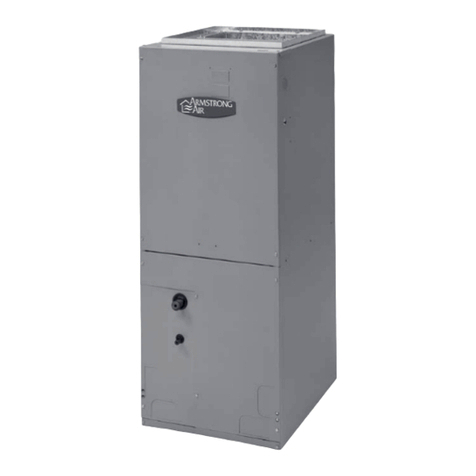
Armstrong Air
Armstrong Air RBCS2 Series installation instructions
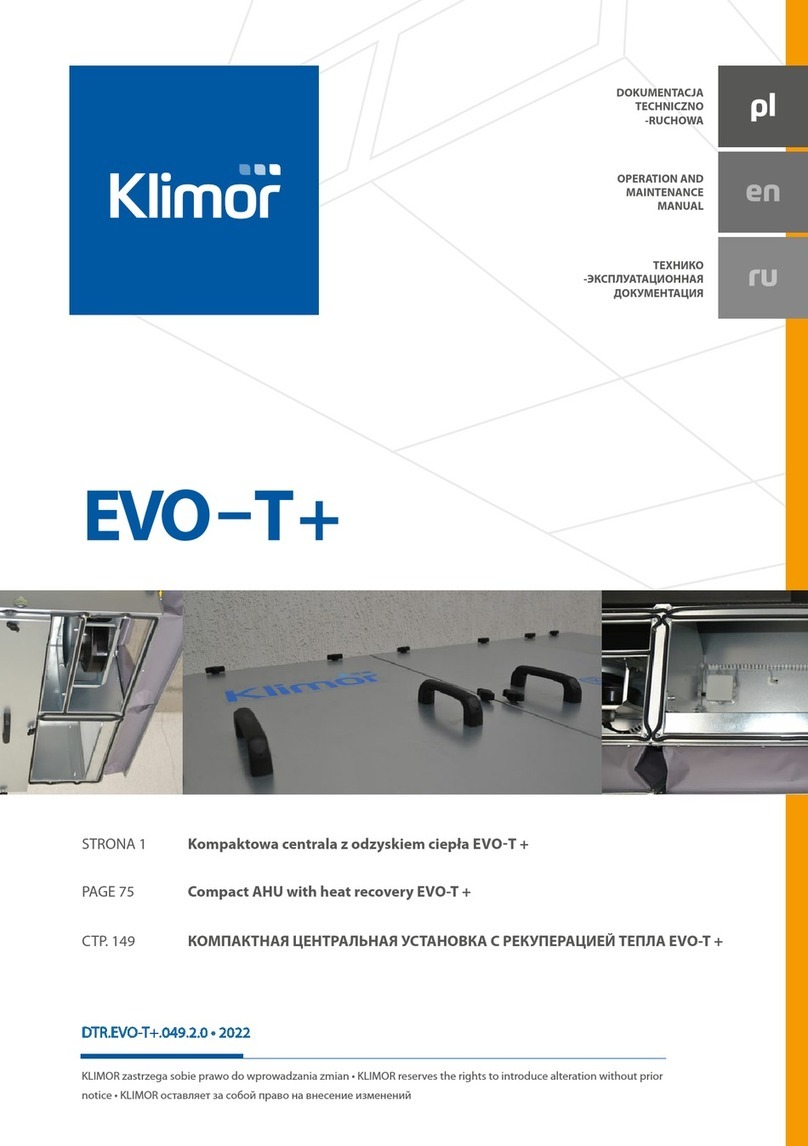
Klimor
Klimor EVO-T Plus Operation and maintenance manual

York
York MILLENNIUM ND360 Technical guide

Lindab
Lindab Premax Installation instruction
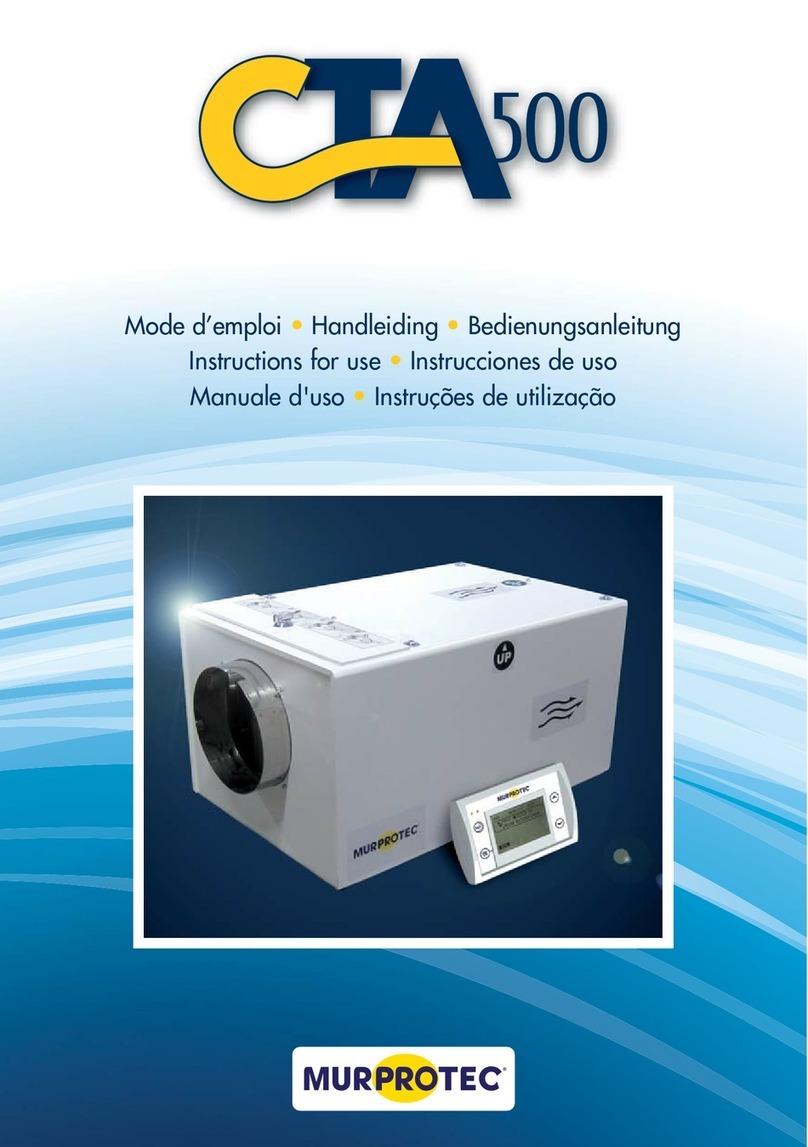
murprotec
murprotec CTA 500 Instructions for use

Wolf
Wolf KG Standard Installation and maintenance instructions

Swegon
Swegon CASA R5H Smart Installation, commissioning and maintenance instruction
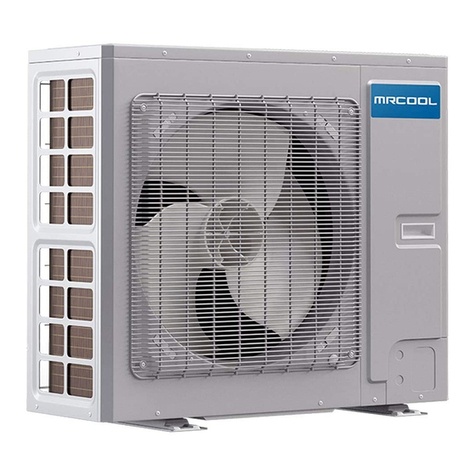
MrCool
MrCool Universal Series owner's manual
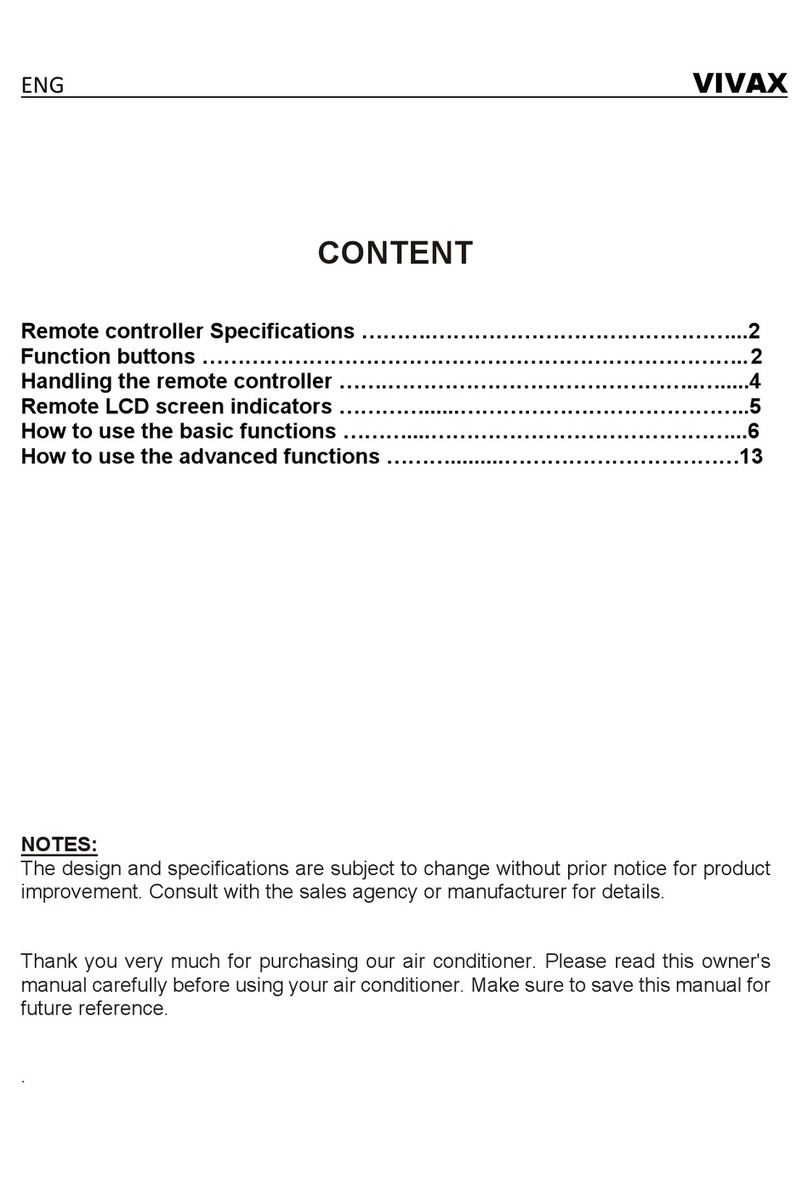
Vivax
Vivax RG10N2 (D2S) manual
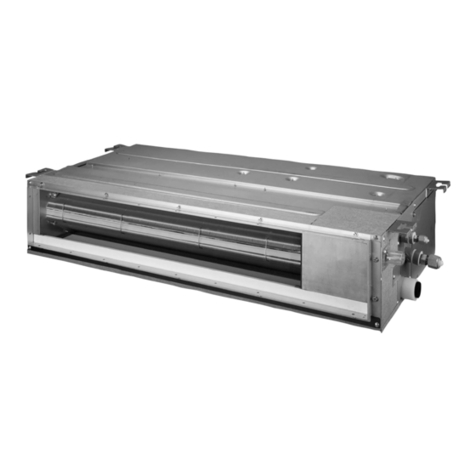
Daikin
Daikin FXDQ-SPV1 engineering data
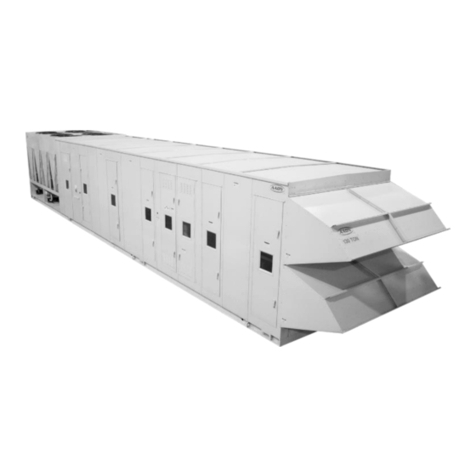
AAON
AAON RZ Series Installation operation & maintenance

BLAUBERG Ventilatoren
BLAUBERG Ventilatoren KOMFORT ERV D150 user manual
